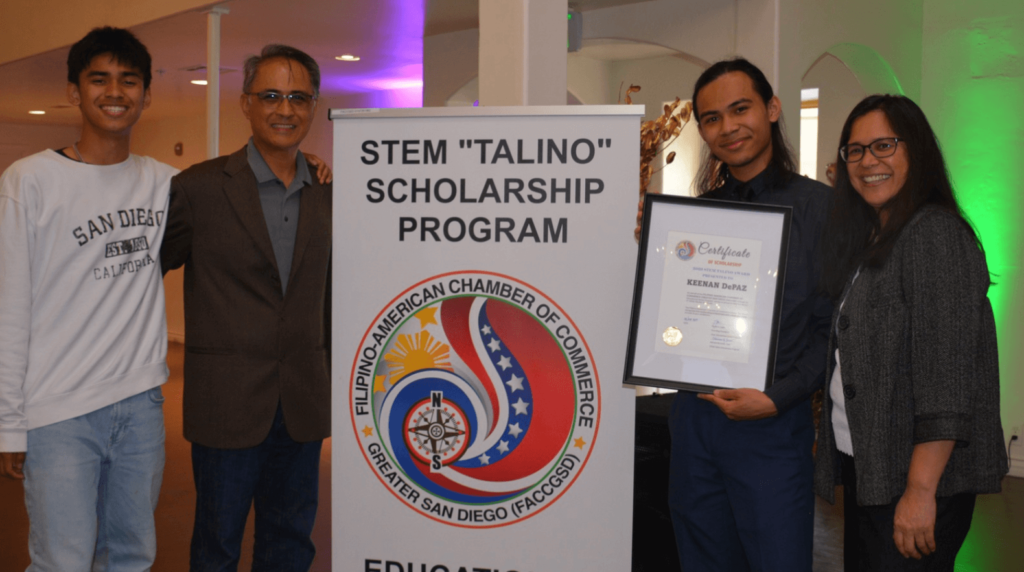2024 STEM Talino Scholarship Application NOW OPEN!
FILIPINO AMERICAN CHAMBER OF COMMERCE GREATER SAN DIEGO (FACCGSD) launched the STEM Talino Scholarship Program in 2020 as part of investment in the next generation of STEM talent.
Each year the STEM Talino Scholarship Program awards two $1,000 scholarships to high school students pursuing a college education in the STEM field.
The scholarship is open to graduating high school seniors. Applications will be reviewed by the FACCGSD Board of Directors and the scholarship winner will be announced to the community in a special ceremony (Date TBD).
STEM: Science, Technology, Engineering and Math, including Computer Science & Arts
The Science, Technology, Engineering, and Mathematics (STEM) Scholarship Program is a scholarship initiative designed to support students pursuing degrees and careers in these fields. STEM fields are considered crucial for innovation, economic growth, and addressing global challenges.
The eligibility criteria and application process for STEM scholarships requirements may include academic excellence, demonstrated interest and commitment to STEM fields, letters of recommendation, essays or personal statements, and sometimes participation in extracurricular activities related to STEM.
Recipients of STEM scholarships often receive financial assistance to cover tuition, fees, books, and sometimes living expenses. Additionally, some programs may offer mentorship opportunities, internships, or research experiences to enhance students’ educational and professional development.
Overall, STEM scholarships play a crucial role in encouraging and supporting the next generation of scientists, engineers, mathematicians, and technologists, helping to ensure a skilled workforce and continued advancements in these critical fields.
Criteria
Academic Excellence: Applicants are often required to have a strong academic record, typically demonstrated by a high GPA or standardized test scores (such as SAT or ACT scores).
STEM Field of Study: Most STEM scholarships require that applicants are pursuing a degree in a STEM-related field such as biology, chemistry, computer science, engineering, mathematics, physics, or a related discipline.
Demonstrated Interest and Commitment: Applicants may need to demonstrate their passion for STEM fields through extracurricular activities, projects, research, or participation in STEM-related clubs or competitions.
Leadership and Community Involvement: Some scholarships may consider applicants’ leadership skills and involvement in their communities, particularly in areas related to STEM education or outreach.
Letters of Recommendation: Many scholarship applications require letters of recommendation from teachers, professors, or mentors who can speak to the applicant’s academic abilities, character, and potential for success in STEM fields.
Essay or Personal Statement: Applicants may be asked to write an essay or personal statement detailing their academic and career goals, their interest in STEM fields, and how they plan to contribute to the field in the future.
Financial Need: While not always a requirement, some STEM scholarships prioritize applicants with demonstrated financial need, particularly those who may face barriers to accessing higher education.
Underrepresented Groups: Some scholarships aim to support diversity and inclusion in STEM fields by specifically targeting underrepresented groups such as women, minorities, individuals with disabilities, or students from low-income backgrounds.
Citizenship or Residency Status: Depending on the scholarship provider, applicants may need to be citizens or legal residents of the country offering the scholarship.
Other Specific Requirements: Scholarship programs may have additional criteria or requirements unique to their funding priorities or the goals of the sponsoring organization.
It’s essential for applicants to carefully review the eligibility criteria and application requirements for each scholarship they are considering and to tailor their application materials accordingly.
OUR STEM TALINO SCHOLARS








